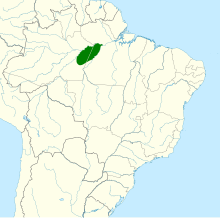| Brown-chested barbet | |
|---|---|
| Conservation status | |
 Least Concern (IUCN 3.1) | |
| Scientific classification | |
| Domain: | Eukaryota |
| Kingdom: | Animalia |
| Phylum: | Chordata |
| Class: | Aves |
| Order: | Piciformes |
| Family: | Capitonidae |
| Genus: | Capito |
| Species: | C. brunneipectus |
| Binomial name | |
| Capito brunneipectus Chapman, 1921 | |

| |
The brown-chested barbet (Capito brunneipectus), also called cinnamon-breasted barbet, is a species of bird in the family Capitonidae, the New World barbets. It is endemic to Brazil's central Amazon Basin.
Taxonomy and systematics
At one time, the brown-chested barbet, black-spotted barbet (Capito niger), and gilded barbet (Capito auratus) were considered conspecific but since the late 20th century have been accepted as individual species that are each other's closest relatives.
The brown-chested barbet is monotypic.
Description
The brown-chested barbet is approximately 18 cm (7.1 in) long; the male weighs approximately 58 g (2.0 oz). The male's crown is dull gold with a wide black patch through the eye below it. Its back is black with yellow streaks. The throat is yellowish-white; below it is a cinnamon breastband and a yellow to olive belly, both with faint streaks. The female is similar but duller and it has more yellowish markings on the wings and its throat is black-spotted cinnamon.
Distribution and habitat
The brown-chested barbet is found south of the Amazon River between the Madeira River on the west and the Tapajós River on the east. The southerly limit of its range is not known. It inhabits the canopy of wet forest.
Behavior
Feeding
The brown-chested barbet is known to eat insects, other arthropods, and fruit. It forages by climbing vines and hopping on branches and twigs. It will join mixed-species foraging flocks.
Breeding
The brown-chested barbet apparently breeds from as early as March into June. No other information about its breeding phenology has been published.
Vocalization
The brown-chested barbet's song is "a rapid 'hoo' trill of short notes" .
Status
The IUCN has assessed the brown-chested barbet as being of Least Concern. However, its "small range, coupled with the fact that so little is known about its habitat requirements and breeding habits, suggests that it should be monitored; its conservation status possibly requires reassessment."
References
- ^ BirdLife International (2020). "Capito brunneipectus". IUCN Red List of Threatened Species. 2020: e.T22681929A173840010. doi:10.2305/IUCN.UK.2020-3.RLTS.T22681929A173840010.en. Retrieved 14 September 2023.
- ^ Gill, F.; Donsker, D.; Rasmussen, P. (January 2021). "IOC World Bird List (v 11.1)". Retrieved January 14, 2021.
- ^ Short, L.L., J. F. M. Horne, and A. Bonan (2020). Brown-chested Barbet (Capito brunneipectus), version 1.0. In Birds of the World (J. del Hoyo, A. Elliott, J. Sargatal, D. A. Christie, and E. de Juana, Editors). Cornell Lab of Ornithology, Ithaca, NY, USA. https://doi.org/10.2173/bow.brcbar1.01 retrieved May 26, 2021
- Remsen, J. V., Jr., J. I. Areta, E. Bonaccorso, S. Claramunt, A. Jaramillo, D. F. Lane, J. F. Pacheco, M. B. Robbins, F. G. Stiles, and K. J. Zimmer. Version 23 May 2021. A classification of the bird species of South America. American Ornithological Society. https://www.museum.lsu.edu/~Remsen/SACCBaseline.htm retrieved May 24, 2021